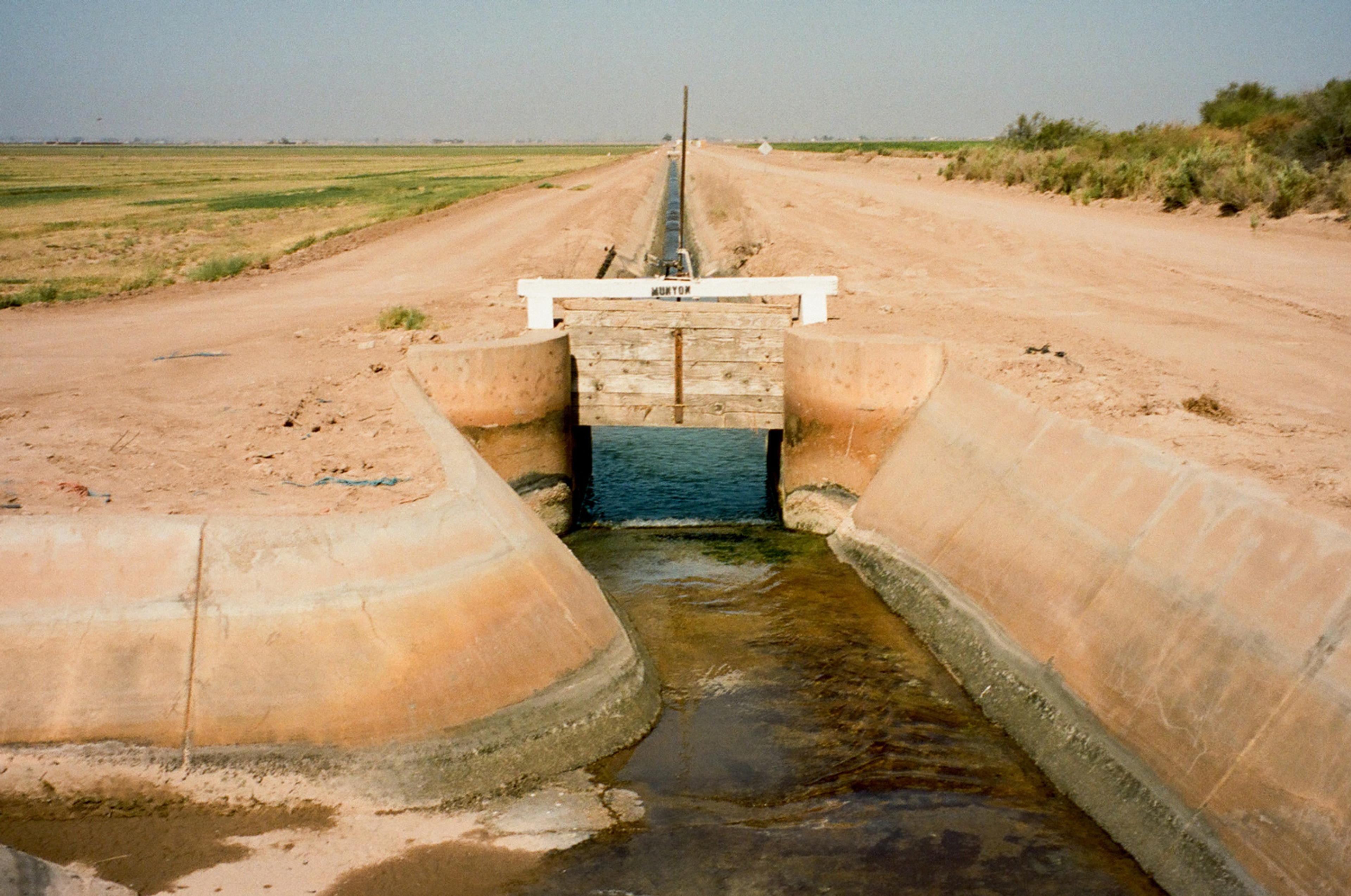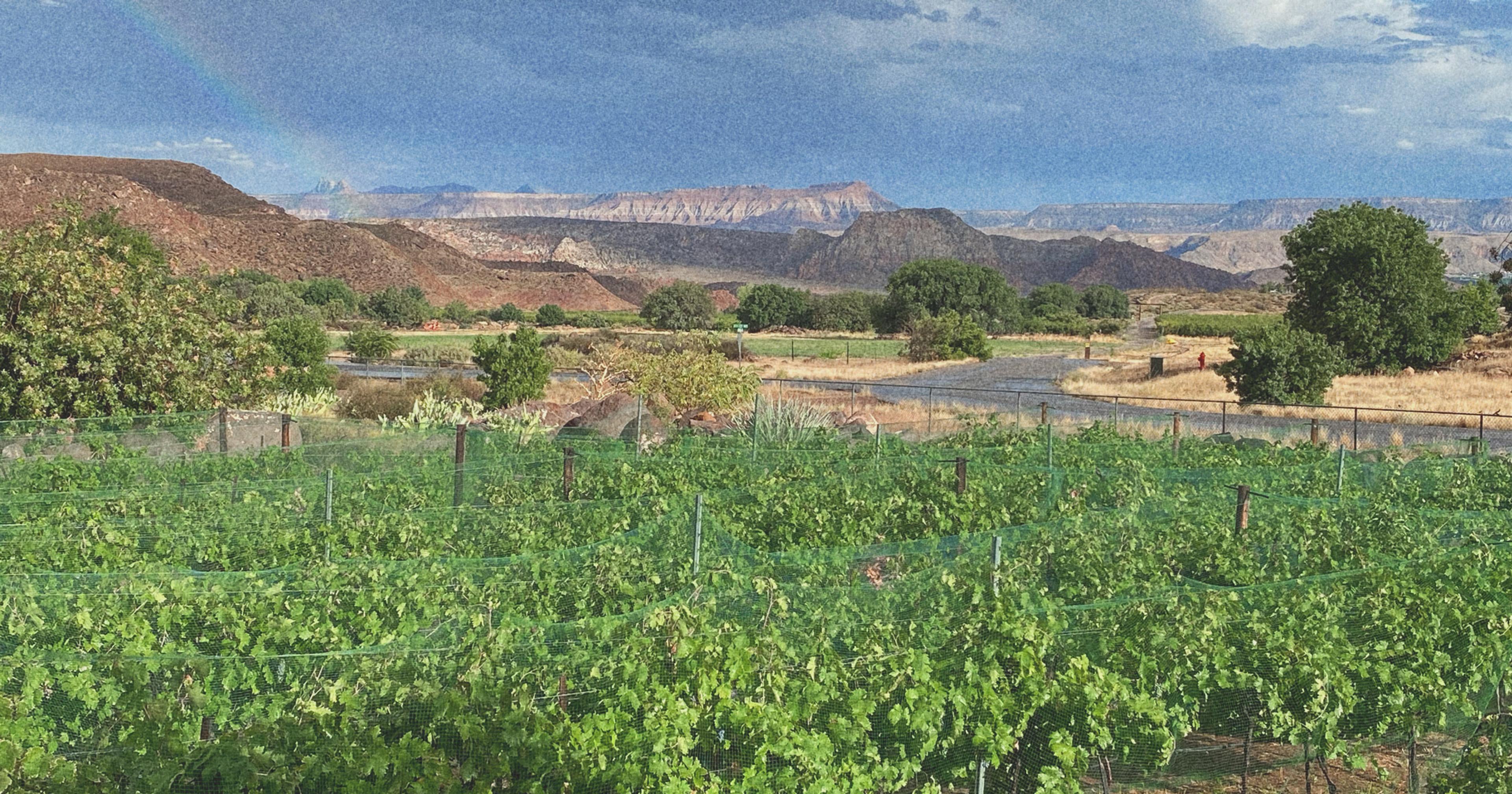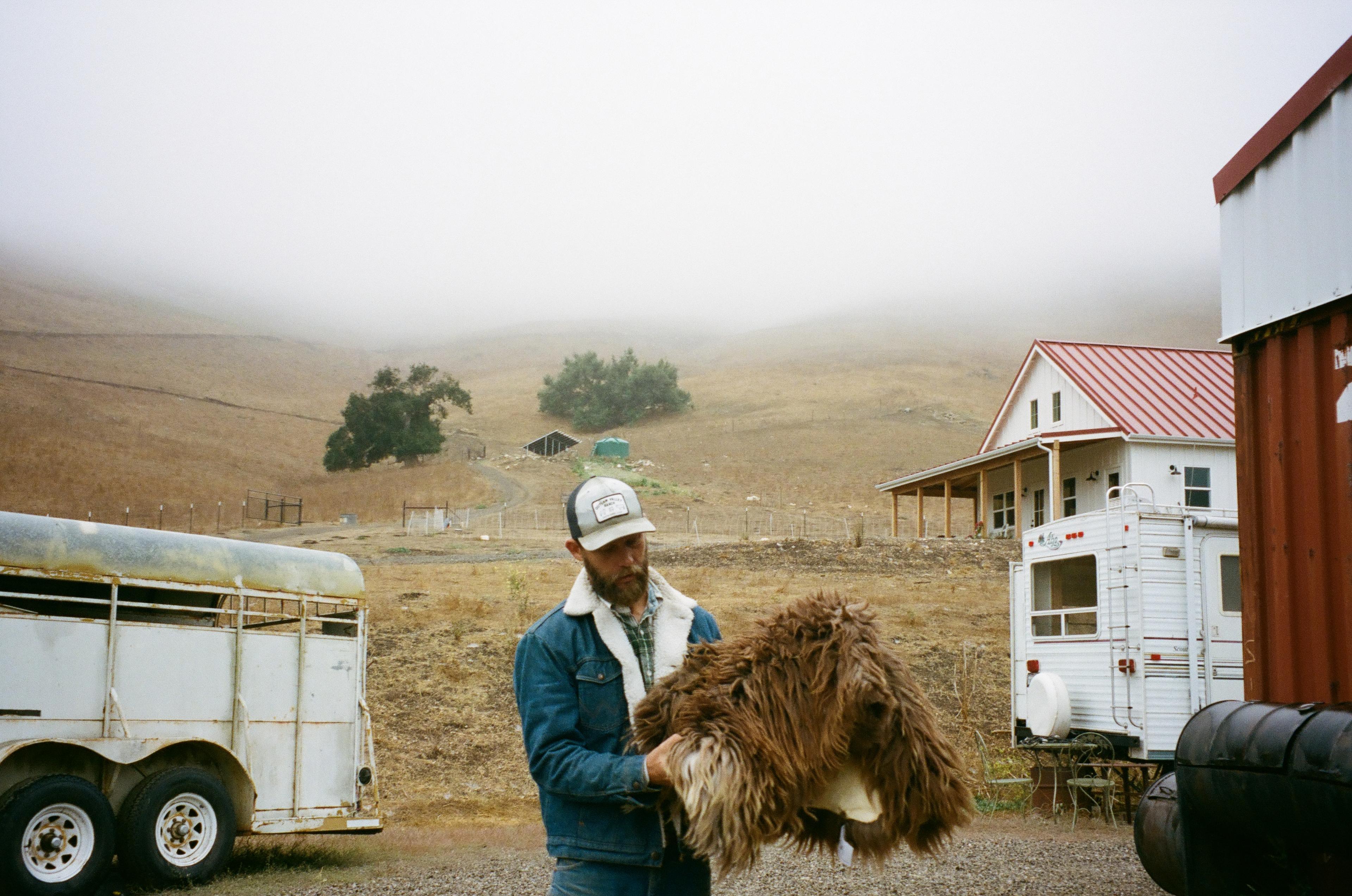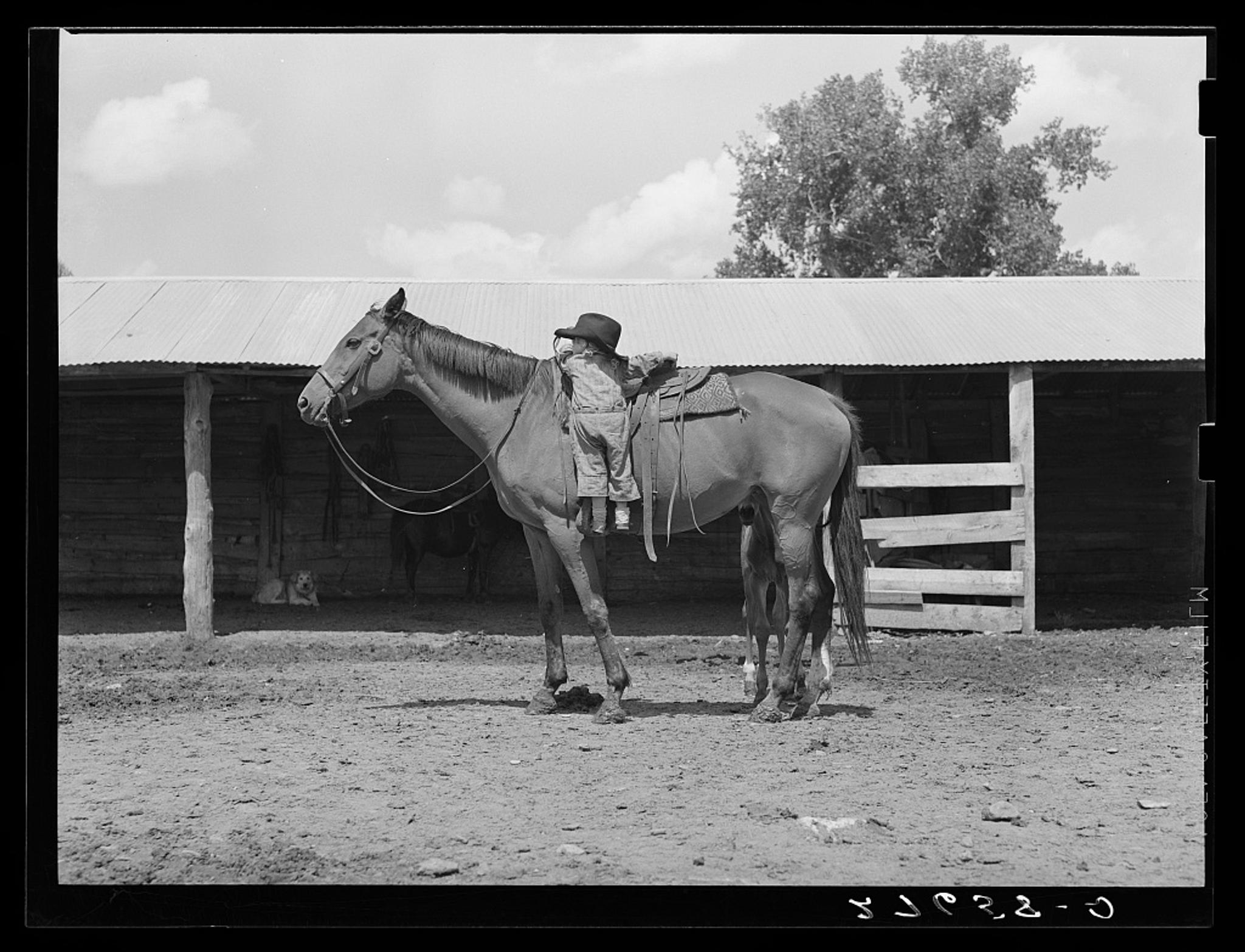Much of the United States’ winter produce is grown in one economically depressed desert county in California with a century-long agricultural history, where a multi-billion dollar lithium mining industry looms on the horizon. Will Imperial Valley agriculture survive?
Drive southbound from Joshua Tree on the 111 and find, to your right, the Salton Sea, the behemoth salt lake. Hydrogen sulfide gas clouds the far rim, vanishing point obliviated. To your left, the Chocolate Mountains appear like a shadow above the desert’s boundless microwave. Gold mines with names like American Girl and Picacho once attracted hotshot prospectors; today, the Chemgold corporation owns the latter, and the former is defunct. Now, these ranges host Marines from Yuma who come to practice their aim. Driving the 35-mile lakefront on the hottest day in August, the daytime temperature registers 118℉. In the pitch of night, respite is 100℉. With the air conditioning turned up, the interior of my windshield burns my hand. On this single-lane highway, there are no floodlights and few exits; on the left bank’s similar Highway 86, neon bright gas stations serve as de facto beacons.
You’d be forgiven for not believing that you are on your way to some of the most productive farmland in the world. Almost all the produce Americans eat in the winter — and much of the alfalfa and Bermuda grass that is baled and fed to cows across the country — grow on Imperial County’s’s 425,000 irrigable acres, where water is available on demand. On this drive, maybe it would also surprise you to know that you’d likely just passed enough untapped lithium to provide the requisite battery materials for every single person in the United States to own an electric vehicle.
Though the Imperial Valley is one of the biggest producers in the American food supply chain and is poised to alter the global trade of lithium, it also has some of the highest unemployment rates in the country. And it’s likely many Americans have never heard of it. “I would say absolutely that this area is unknown. Whenever I try to explain where it’s at, I say, well, it’s kind of by San Diego, kind of by Palm Springs, kind of by Yuma,” says Tyler Brinkerhoff, Imperial Valley historian. “And people are like, so Salvation Mountain? Well, you’re getting close.”
One Hundred Years of Farming the Desert
This perennially warm section of the Yuha and Colorado Deserts — and its position below sea level and downstream of the Colorado River — lent itself to becoming a suitable American winter breadbasket in the early 1900s. That’s when the Imperial Land Company encouraged global settlers to immigrate to the valley and stake a claim on the richly productive land. Before capital development, the river would flood and dry unpredictably, challenging the new farming community.
But in 1928, the Boulder Canyon Project Act both built the Hoover Dam and the All-American Canal, an 82-mile-long aqueduct that stretches from the Colorado River, which delineates Arizona and California, all the way to Imperial County. The resultant engineering allows a farmer today to order water in the afternoon and have it flow to their fields via the irrigation ditches that line the square plots of field the next day.
It becomes clear that Imperial County is a sandbox of extremes, a place where land use can quickly turn into a lose-lose game. In 1905, torrential rainfall caused the irrigation canals that branched from the Colorado River to flood. Two hundred feet below sea level, the Salton Sea was the resultant farming accident. By the 1990s, polluting runoff turned the vacation spot into one of the grandest ecological disasters in the country.
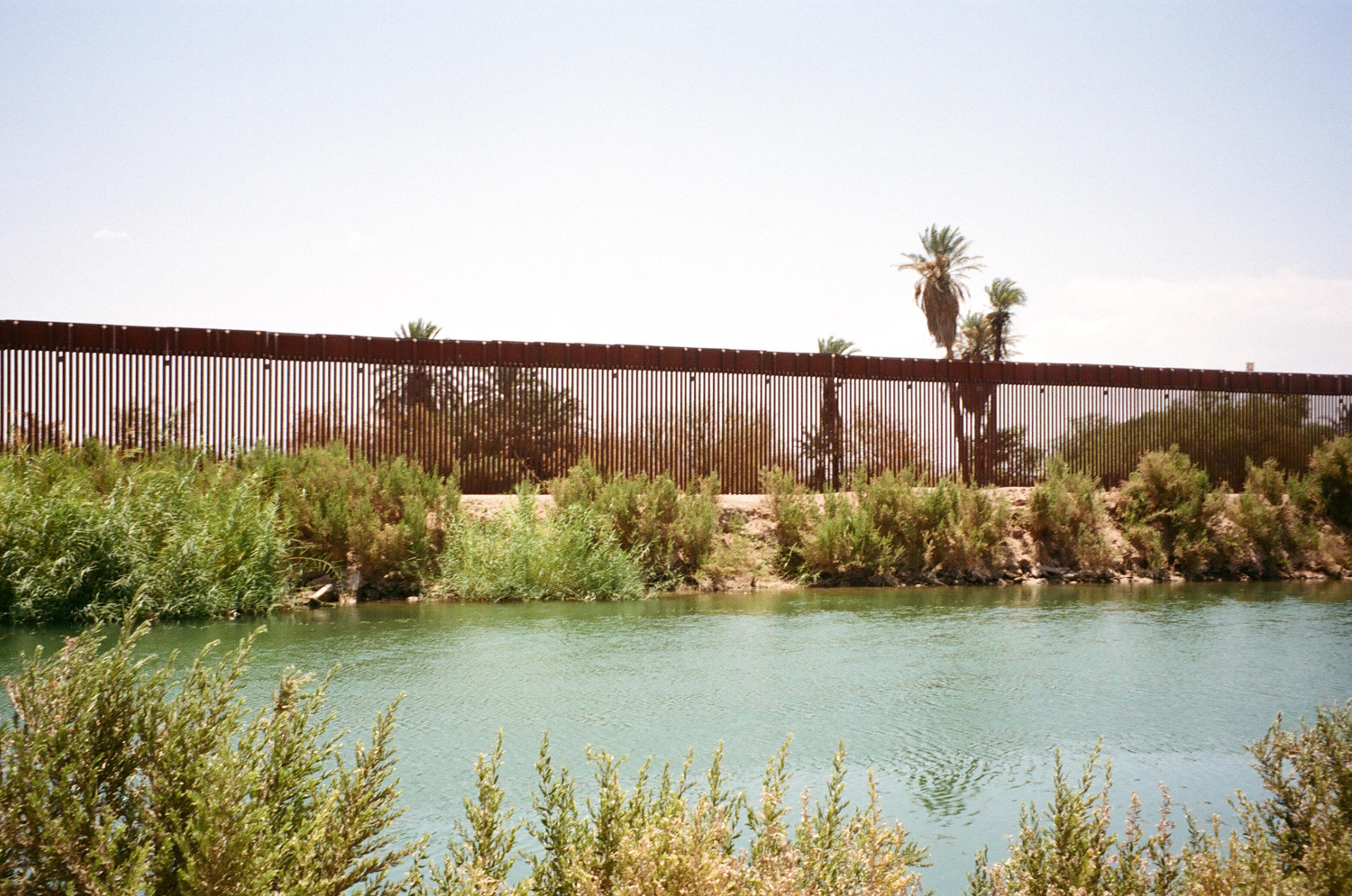
Trevor Tagg’s “island” is a little over a mile from the U.S.-Mexican border and the All-American Canal that runs parallel to it.
Today, the bones of dead fish dress the waterfront like the pebbles lining the shore. Very few live on the sea now, in abandoned Bombay Beach. The nearest town, Niland, had 452 residents in 2021, after a brush fire destroyed 40 homes; but here, just as things contract fast they also expand, and by 2023, the population had risen above pre-fire levels. On the edge of Niland, the anarchist community Slab City — and its tourist attraction, the technicolor Christo-psychedelic land sculpture Salvation Mountain — hangs like a dreamy, lawless tumor off the edge of the town. Past Niland and Slab City, tractors drive on the side of the road, and farm country begins in earnest. In this border county, a supermajority of Imperial County residents are Latino. The twin cities Mexicali and Calexico straddle the wall, which day laborers pass through on their commutes.
At his garage in El Centro, I meet Trevor Tagg, who operates the nearly 3,400 acre West-Gro Farms with his father and brother. He’s been awake for 35 hours straight, baling hay by night, but he still wants to drive me around in his truck. “I’m going to take you down to what we call our ‘island,’” he says, driving straight to the Mexican-American border. His plot of land is a verdant rectangle ringed by a wash of blue-gray solar panels. There’s more profit per acre in solar farming — and virtually no need for labor — compared to traditional farming. But unlike the rest of his family, Tagg refused to sell out his share of the land.

Trevor Tagg with his hay.
After creeping along the border and the All-American Canal that lines it, we head back. “What’s literally a half a mile down the road takes me eight miles to get to because the bridge is closed and has been for 10 or 12 years,” Tagg says. He is vehement that farmers are the most hated people in California. “It’s been a slow burn down the toilet. It’s why I don’t have any peers, any young people. I don’t have any competition in agriculture down here … I’m the youngest person in every meeting I sit in by 20 years.”
When one of the county’s several hundred independently run farms quits the business, Tagg says that newcomers are seldom interested in joining the industry; starting a new operation is extremely cash-intensive, profit margins are slim, and the desert is an isolating, hot environment.
Tagg has just come off what he describes as a two-to-three year produce “bloodbath.” He has many objections to Californian government policy. The cost of labor and gas are more than he’d like to bear. “It’s arguably the most productive farm ground on Earth, because we order water and get it the next day. I just can’t pick up 3,000 acres and move to Texas or Missouri. Tagg cites the cost of labor and other expenses in California as primary roadblocks for his operation and for other local farms.
One such operation, the Spreckels Sugar Company, a 28,000-acre sugar beet plant with a century-long history and payroll of 400 workers, closed down this year. The sugar beets that are in the ground now may be the last ever grown in Imperial County. At the peak of dairy farming in the valley, there were 1,800 dairies; now there’s just one. Local plant closures, transportation fees, and cow-cooling costs influenced these sites to be replaced by dairies in Chino, California; now, those dairies are bygone too. In frustration at the relative profit margins of his Californian industry against that of Silicon Valley, Tagg says, “You can’t eat an iPhone,” talking to me on his own.
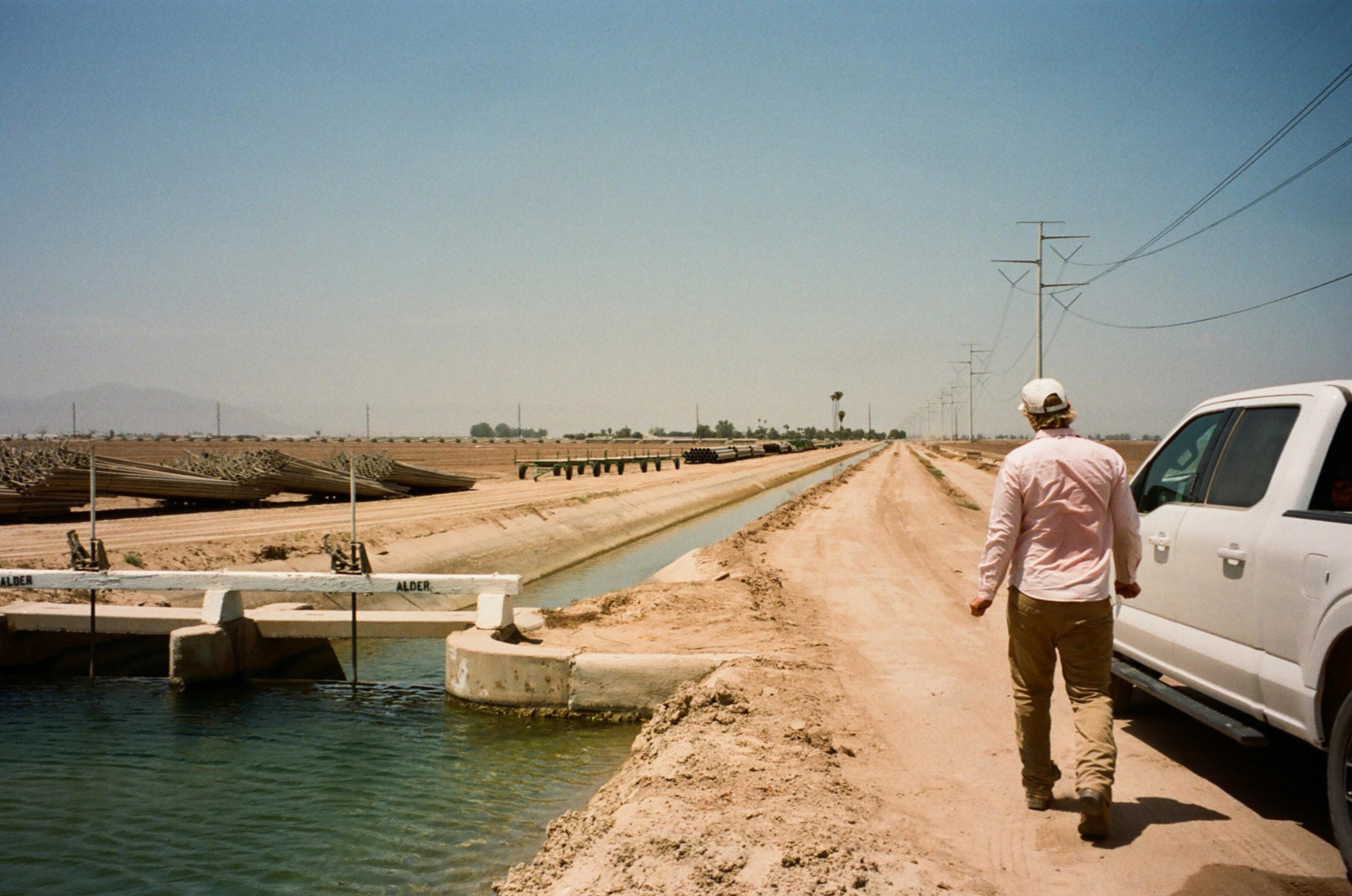
In the blistering heat of the August desert, spending too much time outside of an air conditioned vehicle can quickly lead to heat stroke.
One of Tagg’s first jobs was working for Bryan Ashurst, a fifth-generation beekeeper in the valley. The Ashurst Bee Company was established in 1918 to support the area’s growing agriculture industry. Because North American bee populations are dying at an outsized rate due to neonicotinoid pesticide adoption, parasitic disease, and habitat loss, beekeeping has become a hard business. Now, the average beekeeper simply produces more honeybees to offset this colony collapse. Fifty to 70 percent of Ashurst’s bees will die per year. “You should lose 10 percent,” he says.
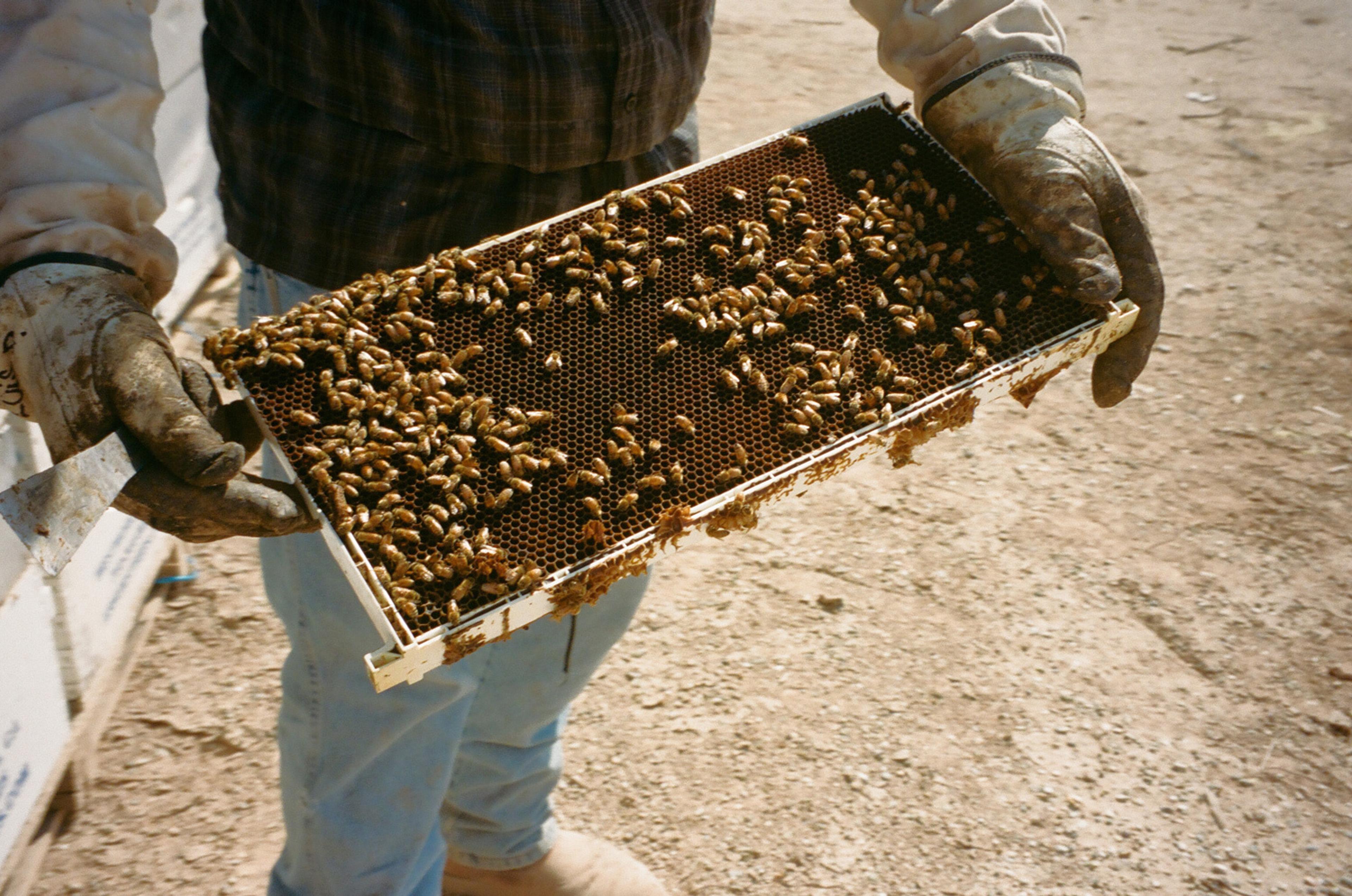
Some of Ashhurst's bees.
As a child, Ashurst and his friends would play in the irrigation pipes surrounding the growing fields. He drives into the fields and shows us the Mullins Pipe, where he earned a scar on his scalp from a childhood dive. He’s remained on this same land at the family beekeeping operation.
For the farmers that grew up in the Imperial Valley on family-owned farms, the past decade has not been simple. Many of these operators say that rising labor costs, regulatory constraints, water restrictions, and an overall rising cost of doing business are contributing to the fear that the Imperial Valley farm business is not delivering local residents the promise of bounty that it was sold on a hundred years ago.
At the same time, the county has become a key player in the national food supply chain: American consumers will still need winter produce (and cows, their hay). These lithium mines, which are slated to line the Salton Sea, 20 miles away from Brawley, the town at the approximate geographic center of farm country,are still in early stages of development.
One of these mine projects, Controlled Thermal Resources’ Hell’s Kitchen, plans to engineer small-physical-footprint, closed-loop mines with nearly no carbon emissions. Unlike open pit mining, CTR’s planned process is one of the cleanest lithium mining proposals in the country, and perhaps the world. Even with the promise of sustainable design, the process would require a modest allotment of water from the Imperial Irrigation District.
In 2020, CTR signed a contract with the IID to provide a 25-year term supply of 40 megawatts of geothermal energy yearly from their yet unbuilt Hell’s Kitchen facility. Even if mines like Hell’s Kitchen have little environmental impact on the valley, the economic conditions created within a region Governor Gavin Newsom once called “the Saudi Arabia of Lithium” are of local concern.
Nobody knows what will happen next.
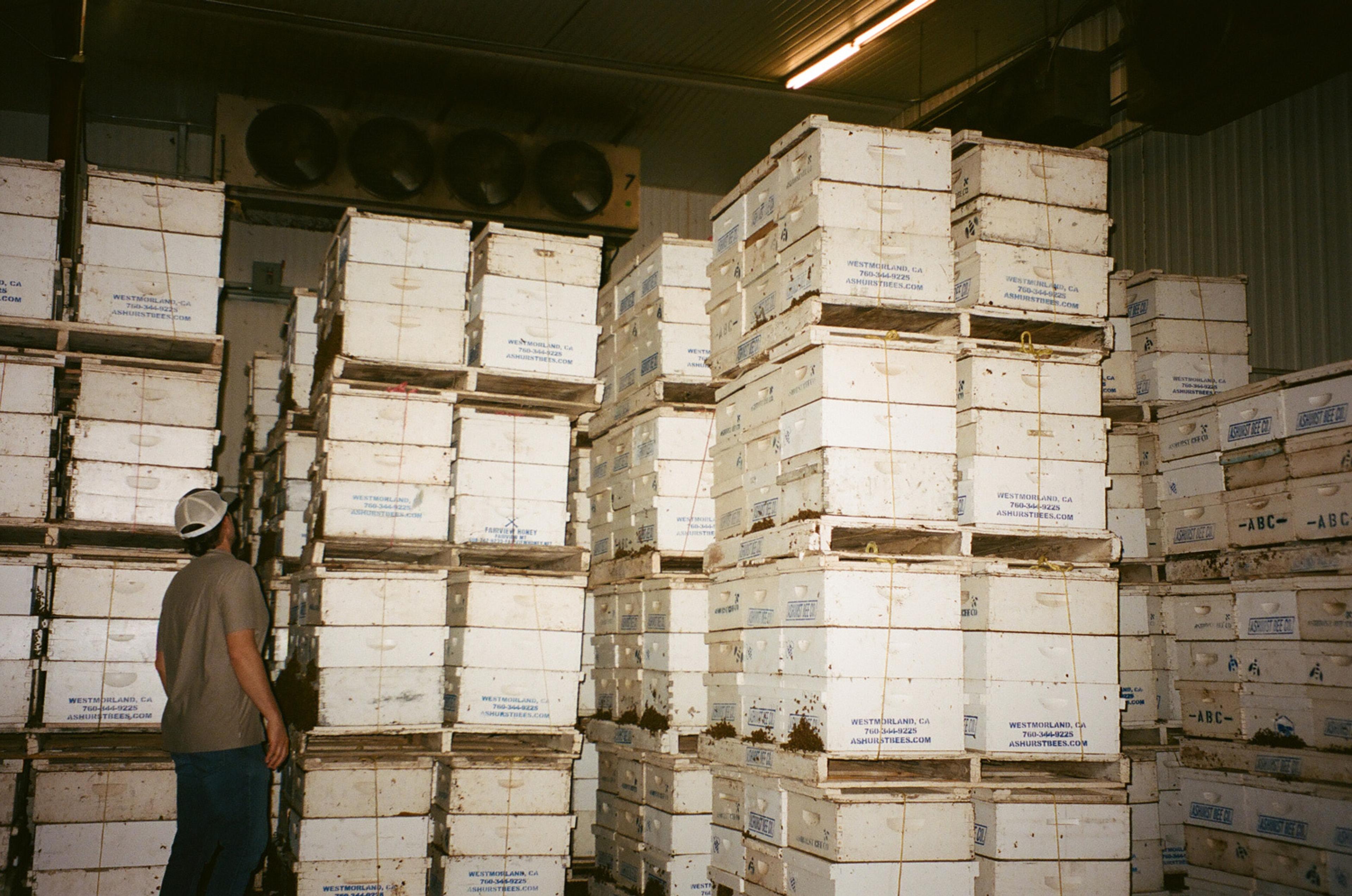
Cold, low-oxygen bee storage offers a “brood break” to slow the spread of parasites.
It must be strange, I think, to spend your life among the lettuce, carrots, onions, and spinach that are destined to end up on dinner tables across the country. Farmers send the product of their labor to such varied locations, but cannot themself move their means of production. As costs continue to punch the sustainability of the farming business down, these farmers struggle with the location of their land. “I guess we’re paying the penalty for being here,” Ashurst says.
On lithium: “Okay, I don’t like it. It worries me a little bit.” In the wake of so many existing challenges, Ashurst’s not sure how the county will react to the new lithium industry. He considers Montana, where he runs another pollination-and-honey operation. There, he says, “You can’t hire locals. They don’t work for you because they either work on their own farm, or the family farm, while [the locals] work in the oil field.” The presence of a new commodity industry in farm country has the ability to quickly impact what are often fairly small local labor markets.
The White Gold Rush
By the bulbous eastern tip of the Salton Sea, I drive three and a half miles down a gravel road to visit an unmarked test site. An oxidized metal structure seated on otherwise blank, unfootprinted desert land, the two brine straws and sole extraction rig looking like a Richard Serra sculpture of a mine, rather than a mine itself. It’s so hot that standing outside for 15 minutes causes my phone to overheat and shut down. (The first time I visited the Salton Sea, in January, the weather was pleasantly warm, and the land was covered in shocking miles of unmanned vegetation. During this winter drive, the Salton Sea’s chemical haze made the body of water look endless. I felt alone enough that I could fall off the edge of the earth into the toxic lake.)
I’ve been invited here by Jim Turner, president of CTR, the developer of Hell’s Kitchen (named after a mid-century Salton Sea dance hall) mining and geothermal energy project, one of three new endeavors to mine lithium in Imperial County. BHE Renewables (a subsidiary of Berkshire Hathaway Energy) and Energy Source Minerals are the other two players in the region. Turner is soft spoken, but he’s grown used to teaching local residents about what’s happening in this corner of the country he’s found his career in. “There’s no reason to bring your bathing suit and go to the Salton Sea,” he says, “so it’s ... [a matter of] constant education.”

Lithium brine enters S-shaped “straws” below the surface of the earth at approximately 700 degrees Fahrenheit and cools to 500 degrees Fahrenheit by the time it reaches the surface.
Every chart that shows the past tally and the future growth of the global demand for lithium displays a comically impressive exponential curve. The transformation of the car market means that now 90 percent of lithium mined is now used in the electric vehicle battery production. Once responsible for a third of the world’s lithium production, the United States is now only responsible for a sliver of the total mined supply; Australia, Chile, and China now export the majority of what’s commercially available. But across the United States, new mining outfits have thrown their hat in the ring to meet rising demand.
Since the 1980s, the region’s lithium brine has been used for geothermal energy, but not mined. Imperial’s motherlode — estimated to contain 127,000 metric tons of lithium carbonate equivalent per year — was discovered underneath the briny, earthen crust alongside the Salton Sea. In one CTR brochure, a terminal proposed project stage claims between 175,000 and 250,000 tons per year are capable of being produced. That’s a greater planned yearly output than what was proposed by Nevada’s Thacker Pass, which boasts that it sits on the “world’s largest known measured lithium Resource and Reserve.” Basically, there’s a hell of a lot of lithium.
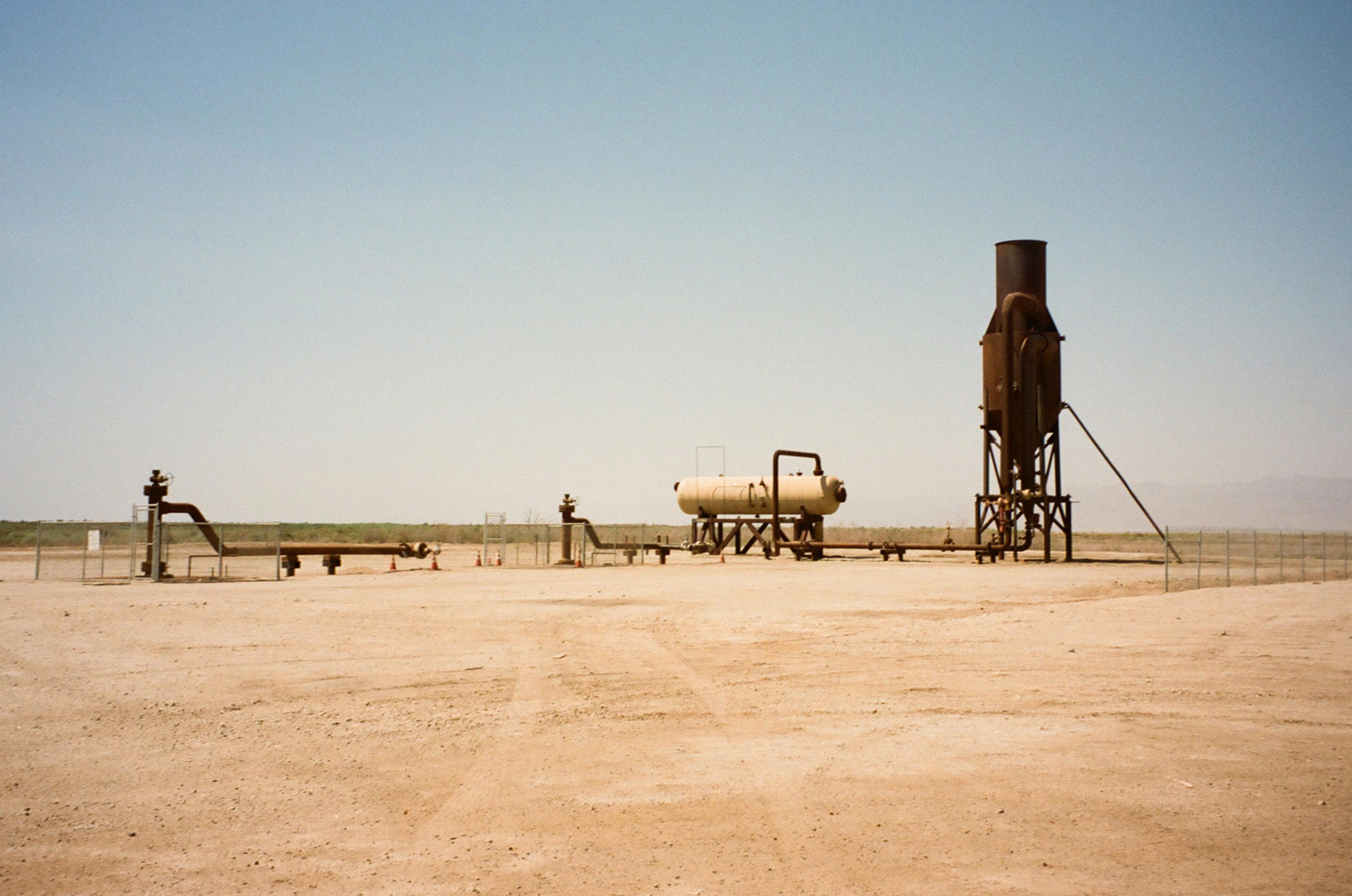
The unmarked Hell’s Kitchen test rig lies three miles down an inconspicuous gravel road.
But neither Thacker Pass nor Hell’s Kitchen have yet come into operation. Currently working with a California Entitlement Permit, CTR is seeking the federal permit that will enable them to complete their multi-billion dollar equity raise. The longer the permit process, the bigger the worry.
Despite this, Turner says that he has an excellent relationship with the government’s office. Gavin Newsom has even come to visit. It’s a far cry from Tagg’s understanding of Californian government policy: “a parasitic load on us.” Stellantis and General Motors have already developed working relationships as buyers of the new lithium. Across the United States, the white gold rush has begun.
Pending permitting and subsequent equity raises, CTR’s extraction rig is slated to be a dual geothermal energy and lithium mineral mining outfit. S-shaped pipes pump 700 degree brine to the surface, where the heat energy is converted to electricity. The Hell’s Kitchen project plans to collaborate with the energy developer Baker Hughes to power AI data centers across the country.
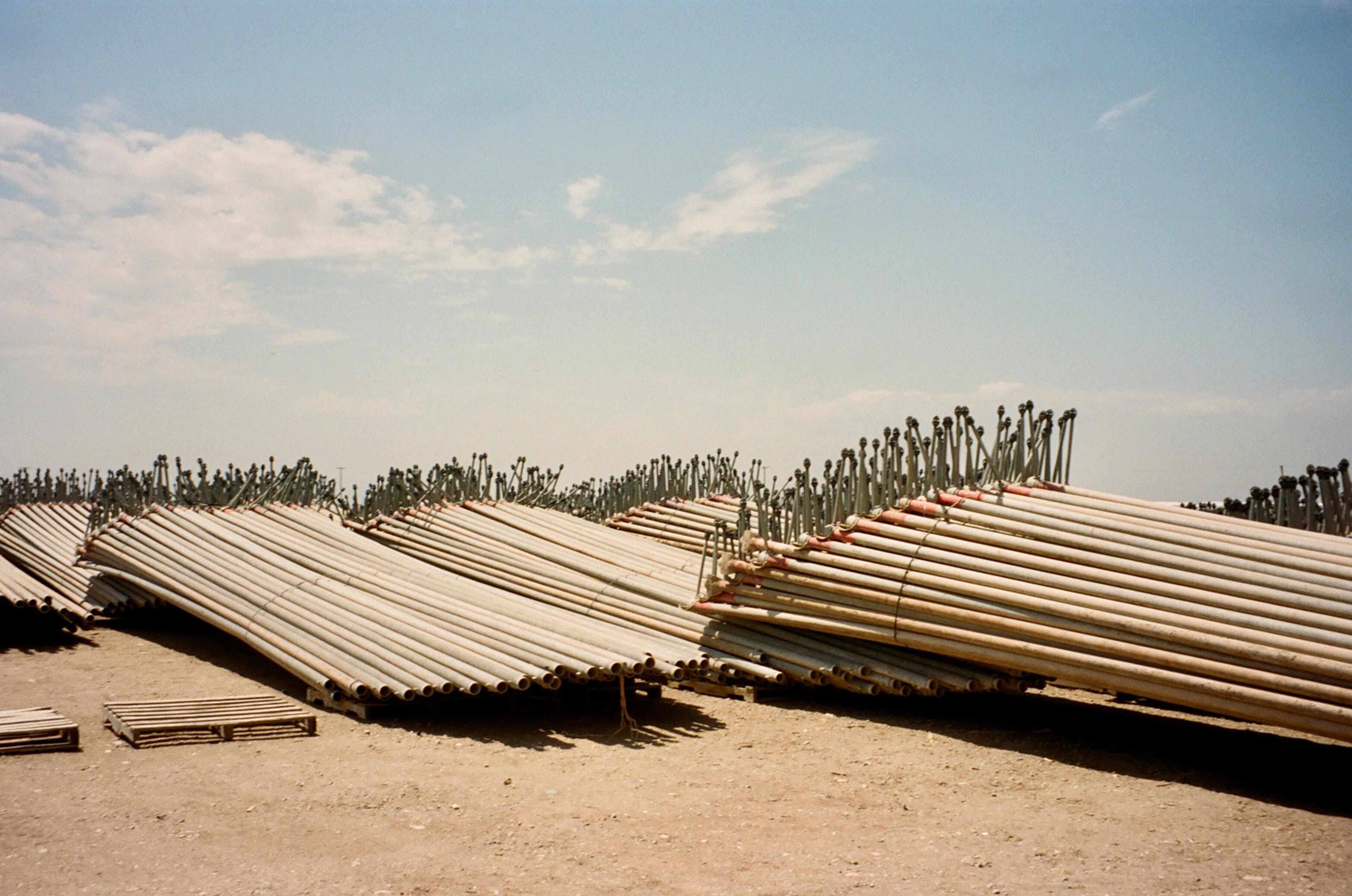
Each bundle of 180 “sticks” (the irrigation pipes that run water through fields) is worth approximately $9,000.
These rigs will need a water allotment to function — about 4,000 acre-feet a year. These water batches, Turner stresses, would be reused multiple times in the cooling cycle. Unlike in strict geothermal operations, where the heated brine is not used to make commodity-grade lithium, Hell’s Kitchen will be optimized for lithium production. “When we evaporate water, we’ll grab it, condense it back to a liquid, we’ll use it somewhere else.” But even though the need is relatively small, water in Imperial Valley is a precious resource, and any new claim to it is cause for review.
California, Manifested
In this downward corner of the United States, a new mining industry springing from the ground will likely be a transformative vector for the local environment and economy. The mines, with their promise of well-paying, local-hire jobs, could change the course of economic prospects in the Imperial Valley.
Exactly how things will transform, though, is unpredictable; if past attempts to re-address the Imperial Valley prove illustrative, whatever the intention of change, troublesome externalities follow. The offspring of settlers who came from around the world to find prosperity in the desert now find themselves wishing they could move their land to another state. Canals built to facilitate crop growth overflowed and spawned a man-made pool larger than Lake Tahoe. The Salton Sea’s Bombay Beach was once a waterski paradise for mid-century Hollywood stars; now, it is an asthma-inducing, ecologically crippled ghost town. As the county’s farmers struggle for economic viability, who knows if a yet-unbuilt lithium mine will save things or tear them further down.

In 2024, Imperial Valley agriculturalists produced over $360 million dollars of alfalfa hay and Bermuda grass hay.
But it is certain that these mines will change the story of the Imperial Valley. Gavin Newsom, has already overwritten the valley’s name altogether: “We’re advancing a vision for Lithium Valley that promises to become a global source of critical minerals while also powering a new economic boom for the region.” In a June op-ed, Brawley mayor Gil Rebollar wrote, “During [Newsom’s] last visit, [he] declared, “The future happens here first …” He was talking about Lithium Valley, and he was bold and on point in proclaiming our potential to lead the transition to a greener economy. [But] we cannot ignore what is already here: The invisible people connected by our waning cornerstone agriculture industry.”
In the Imperial Valley’s century-long history of American expansionism, ecological disaster, and resource prospecting, transformation is certain, especially the kind of change that threatens to overwrite local ways of life. The century-long history of commercial farming in the Imperial Valley feels susceptible to being superseded by a new mineral future.
What I know is that the Imperial Valley, of all isolated American counties, contains an extreme capacity for American desire to extract from the land. This manifestive agita pools like water runoff in the ancient Colorado Desert. In this singular 4,500-square mile area, gold has been dug up; geothermal and solar energy have been developed at scale; the food you eat, and, quite possibly, the car you drive, will be indebted to this dirt.
I’m repeatedly told that Imperial Valley farmers don’t like to play around with landowner rights — you can do whatever you want on your own lawn — but it’s clear that the polycrises of the commodities market can make or break the economic sustainability of the whole valley. Even in this untouristed, secretive corner of the Southwest, the needs and interests of others impinge and overlap and collaborate; no person gets to be truly alone.


